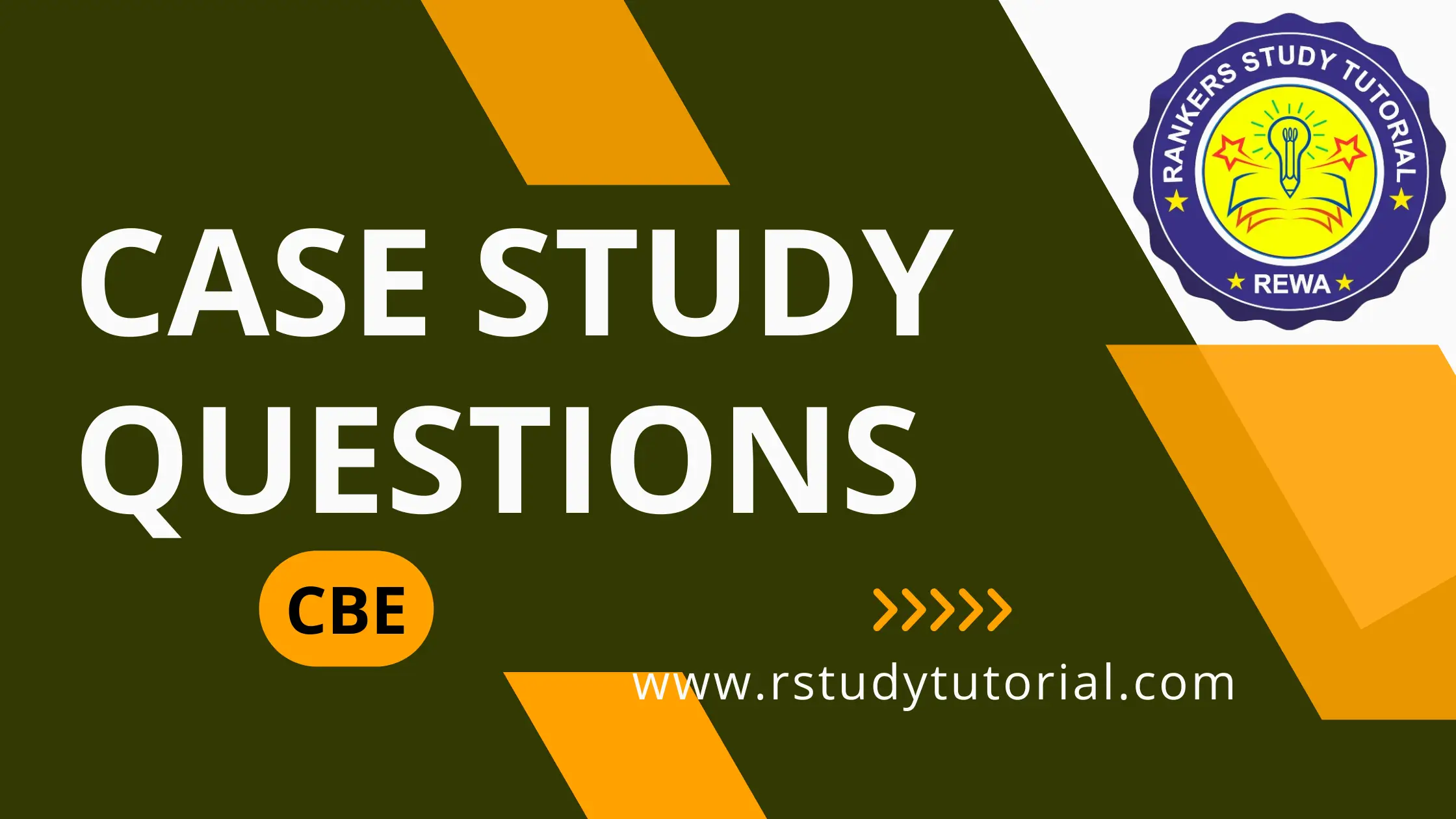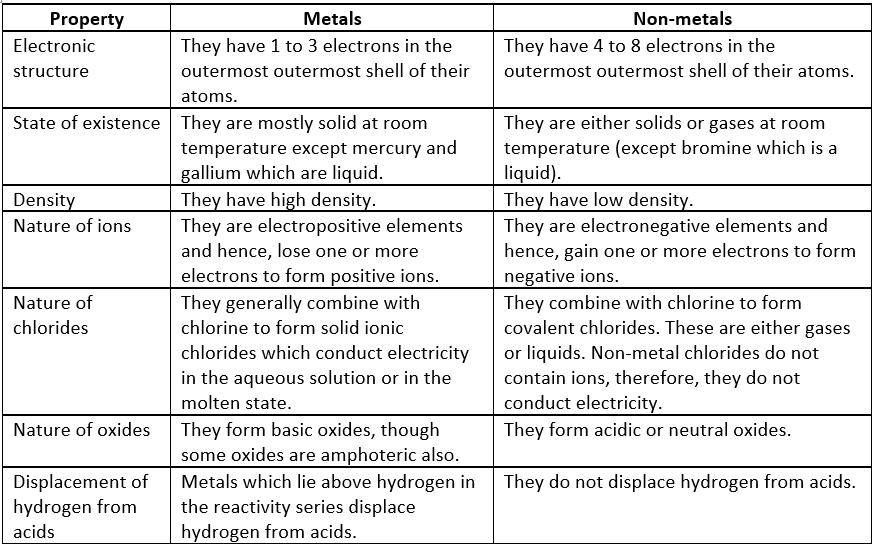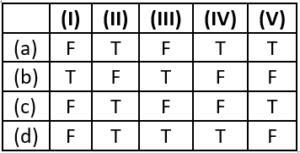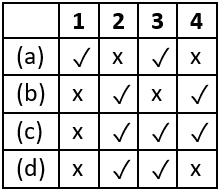Case Study Question 01
Read the following and answer any four questions from 1 to 5.
The chemical reactivity of an element depends upon its electronic configuration. All elements having less than eight electrons in the outermost shell show chemical reactivity. During chemical reactions, atoms of all elements tend to achieve a completely filled valence shell. Metals are electropositive in nature. They have tendency to lose one or more electrons present in the valence shell of their atoms to form cations and achieve nearest noble gas configuration. The compounds formed by the transfer of electrons from one element to other are known as ionic or electrovalent compounds.
Question.1. The electronic configurations of three elements X, Y and Z are:
X: 2
Y: 2,8,7
Z: 2,8,2
Which of the following is correct regarding these elements?
(a) X is a metal.
(c) Z is a non-metal.
(b) Y is a metal.
(d) Y is a non-metal and Z is a metal.
Question.2. Element X reacts with element Y to form a compound Z. During the formation of compound Z, atoms of X lose one electron each whereas atoms of Y gain one electron each. Which of the following properties is not shown by compound Z?
(a) High melting point
(b) Low melting point
(c) Occurrence as solid
(d) Conduction of electricity in molten state
Question.3. Which of the following is correct representation of formation of magnesium chloride?
(a) 
(c)

Question.4. The electronic configuration of sodium ion is
(a) 2,8,8
(b) 2,8,2
(c) 2,6
(d) 2,8
Question.5. Which of the following represents an electropositive element?
(a) 2,8,6
(b) 2,8,8
(c) 2,8,8,1
(d) 2,7
Ans.1. (d)
Ans.2. (b)
‘Z’ is an ionic compound.
Ans.3. (a)

Ans.4. (d)
(a) and (d) represent electronegative elements and (b) represents a noble gas.
Case Study Question 02
Read the following and answer any four questions from 1 to 5.
The arrangement of metals in a vertical column in the decreasing order of their reactivities is called the reactivity series or activity series of metals. The most reactive metal is at the top position of the reactivity series. The least reactive metal is at the bottom of the reactivity series.
Hydrogen, though a non-metal, has been included in the activity series of metals only for comparison. Apart from it, the hydrogen atom also has tendency to lose its valence electron and form cation which behaves like metal.
H \rightarrow H^{+}+e^{-}
Question.1. Which metal can be displaced by copper from its salt solution?
(a) Zinc
(b) Silver
(c) Iron
(d) Lead
Question.2. An element ‘X’ after reacting with acids liberates hydrogen gas and can displace lead and mercury from their salt solutions. The metal ‘X’ is
(a) copper
(b) gold
(c) calcium
(d) hydrogen
Question.3. The most reactive metal is
(a) potassium
(b) barium
(c) zinc
(d) calcium
Question.4. The metal which does not liberate hydrogen gas after reacting with acid is
(a) zinc
(b) lead
(c) iron
(d) gold
Question.5. Which of the following metals does not react with water at all?
(I) Sodium
(II) Copper
(III) Aluminium
(IV) Lead
(a) I and III only
(b) IV only
(c) II and IV only
(d) I, II, III and IV
Ans.1. (b)
Copper is more reactive than silver thus, it can displace silver from its salt solution.
Ans.2. (c)
Calcium is more reactive than lead and mercury.
Ans.3. (a)
Potassium is present at the top of the activity series.
Ans.4. (d)
Gold is below hydrogen in the reactivity series so, it does not liberate hydrogen gas on reaction with acids.
Ans.5. (c)
Metals such as lead, copper, silver and gold do not react with water at all.
Case Study Question 03
Read the following and answer any four questions from 1 to 5.
Metals as we know, are very useful in all fields, industries in particular. Non-metals are no less in any way. Oxygen present in air is essential for breathing as well as for combustion. Non-metals form a large number of compounds which are extremely useful, e.g., ammonia, nitric acid, sulphuric acid, etc.
Non-metals are found to exist in three states of matter. Only solid non-metals are expected to be hard however, they have low density and are brittle. They usually have low melting and boiling points and are poor conductors of electricity.
Question.1. ________ is a non-metal but is lustrous.
(a) Phosphorus
(b) Sulphur
(c) Bromine
(d) Iodine
Question.2. Which of the following is known as ‘King of chemicals’?
(a) Urea
(b) Ammonia
(c) Sulphuric acid
(d) Nitric acid
Question.3. Which of the following non-metals is a liquid?
(a) Carbon
(b) Bromine
(c) Iodine
(d) Sulphur
Question.4. Hydrogen is used
(a) for the synthesis of ammonia
(b) for the synthesis of methyl alcohol
(c) in welding torches
(d) all of these.
Question.5. Generally, non-metals are bad conductors of electricity but ‘X’ which is a form of carbon is a good conductor of electricity and is an exceptional non-metal. ‘X’ is
(a) diamond
(b) graphite
(c) coal
(d) coke
Ans.1. (d)
Iodine is a lustrous non-metal.
Ans.2. (c)
H_{2}SO_{4} is known as ‘King of Chemicals.
Ans.3. (b)
Bromine exists as a liquid.
Ans.4. (d)
Ans.5. (b)
Graphite conducts electricity because of the delocalised electrons in its structure.
Case Study Question 04
Read the following and answer any four questions from 1 to 5.
Ionic compound is a chemical compound in which ions are held together by ionic bonds. An ionic bond is the type of chemical bond in which two oppositely charged ions are held through electrostatic forces. We know that, metal atoms have loosely bound valence electrons in their valence shell and non-metal atoms need electrons in their valence shell to attain noble gas configuration. The metal atom loses the valence electrons while non-metal atom accepts these electrons. By losing electrons, metal atoms change to cations and by accepting electrons, non-metals form anions. Ionic compounds are generally solid and exist in the form of crystal. They have high melting and boiling points.
Question.1. Which of the following can change to a cation?
(a) Fluorine
(b) Oxygen
(c) Potassium
(d) Neon
Question.2. Which of the following can change to an anion?
(a) Iodine
(b) Magnesium
(c) Calcium
(d) Xenon
Question.3. Ionic compounds are soluble in ___________.
(a) Kerosene
(b) Petrol
(c) Water
(d) None of these
Question.4. Which of the following statements is correct about ionic compounds?
I. They conduct electricity in solid state.
II. They conduct electricity in solutions.
III. They conduct electricity in molten state.
(a) I only
(b) II only
(c) III only
(d) II and III only
Question.5. Select the incorrect statement.
(a) Ionic compounds are generally brittle.
(b) Ions are the fundamental units of ionic compounds.
(c) Formation of ionic bonds involve sharing of electrons.
(d) NaCl is an ionic compound.
Ans.1. (c)
Potassium, being a metal, can change to cation by losing its valence electron.
Ans.2. (a)
Iodine, being a non-metal, can change to anion by gaining electron.
Ans.3. (c)
Ionic compounds are generally soluble in water and insoluble in kerosene and petrol.
Ans.4. (d)
Ionic compounds do not conduct electricity in solid state as ions are very closely packed and are free to move.
Ans.5. (c)
Formation of ionic bonds involve complete transfer of electrons from metal atom to non-metal atom.
Case Study Question 05
Read the following and answer any four questions from 1 to 5.
An element is a pure substance made up of same kind of atoms. At present, nearly 118 elements are known but all of them do not occur free in nature, some of them have been synthesized by artificial methods. Based on their properties, they are mainly classified as metals and non-metals. Metals are those elements which lose electrons and form positive ions i.e., they are electropositive in nature. They are generally hard, good conductors of heat and electricity, malleable, ductile and have striking lustre. They have a significant role to play in our daily life.
Question.1. Metals which are of vital importance to the national defence, energy and industry sector are called strategic metals. Which of the following is a strategic metal?
(a) Titanium
(b) Zirconium
(c) Manganese
(d) All of these
Question.2. Which metal is the best conductor of electricity?
(a) Silver
(b) Platinum
(c) Nickel
(d) Iron
Question.3. Which of the following metals is not a coinage metal?
(a) Copper
(b) Silver
(c) Iron
(d) Gold
Question.4. Which of the following are the most malleable metals?
(I) Sodium
(II) Gold
(III) Potassium
(IV) Silver
(a) (I) and (IV)
(b) (II) and (III)
(c) (III) and (IV)
(d) (II) and (IV)
Question.5. Identify the correct statement(s).
(I) The wires that carry current in our homes have a coating of PVC or a rubber like material.
(II) School bells are made of metals.
(III) Metals do not conduct electricity.
(IV) Metals which produce a sound on striking a hard surface are said to be non-sonorous.
(a) (I) and (III)
(b) (I) and (II)
(c) (III) and (IV)
(d) Only (II)
Ans.1. (d)
Titanium, zirconium and manganese are used in defence equipments as they are light and durable and therefore, are called strategic metals.
Ans.2. (a)
Ans.3. (c)
Copper, silver and gold are called coinage metals because they are used in making coins, jewellery etc.
Ans.4. (d)
Ans.5. (b)
Metals conduct electricity. Metals which produce a sound on striking a hard surface are said to be sonorous.
Case Study Question 06
Read the following and answer any four questions from 1 to 5.
The chemical properties of metals are mostly linked with the electron releasing tendency of their atoms. Greater the tendency, more will be the reactivity of the metal. They react with oxygen, water, hydrogen, acids, etc. Since they can lose electrons, they act as reducing agents. Some reactions of metals are given as :
- Metal + Oxygen → Metal oxide
- Metal + Water → Metal hydroxide + Hydrogen
- Metal + Acid (dilute) → Metal salt + Hydrogen
- Metal X + Salt solution of metal Y → Salt solution of X + Y (Displacement reaction)
Question.1. Metals such as ________ and _________ react so vigorously that they catch fire if kept in the open. Hence, to protect them and to prevent accidental fires, they are kept immersed in
(a) phosphorus, magnesium, water
(c) sodium, potassium, water
(b) sodium, potassium, kerosene oil
(d) tin, lead, alcohol
Question.2. Which of the following pairs will give displacement reaction?
(a) NaCl solution and copper metal
(b) MgCl_{2} solution and aluminium metal
(c) FeSO_{4} solution and silver metal
(d) AgNO_{3} solution and copper metal
Question.3. There are four metals K, L, M and N. Identify them by using the hints given below.
- K forms basic oxide.
- L forms amphoteric oxide.
- Oxide of M dissolves in water to form alkali.
- N does not react with water at all.
(a) K→Zn, L→Al, M→Na, N→Fe
(b) K→Fe, L→Na, M→K, N→Zn
(c) K→K, L→Cu, M→Pb, N→Na
(d) K→Cu, L→Zn, M→K, N→Pb
Question.4. Which metal does not react with dilute hydrochloric acid?
(a) Iron
(b) Sodium
(c) Zinc
(d) Copper
Question.5. Food cans are coated with tin and not with zinc because
(a) zinc is costlier than tin
(b) zinc has a higher melting point than tin
(c) zinc is more reactive than tin
(d) zinc is less reactive than tin.
Ans.1. (b)
Ans.2. (d)
As copper is more reactive than silver, it displaces silver from silver nitrate solution.
Ans.3. (d)
CuO is basic in nature, ZnO is amphoteric in nature.
Oxide of potassium dissolves in water to form alkali.
K_{2}O_{(s)}+H_{2}O_{(l)} \rightarrow 2KOH_{(aq)}
Pb does not react with water at all.
Thus, K, L, M and N are Cu, Zn, K and Pb respectively.
Ans.4. (d)
Ans.5. (c)
Zinc being more reactive than tin can react with food elements kept in food cans.
Case Study Question 07
Read the following and answer any four questions from 1 to 5.
On the basis of reactivity of different metals with oxygen, water and acids as well as displacement reactions, the metals have been arranged in the decreasing order of their reactivities. This arrangement is known as activity series or reactivity series of metals.
The basis of reactivity is the tendency of metals to lose electrons. If a metal can lose electrons easily to form positive ions, it will react readily with other substances. Therefore, it will be a reactive metal. On the other hand, if a meal loses electrons less rapidly to form a positive ion, it will react slowly with other substances. Therefore, such a metal will be less reactive.
Question.1. Which of the following metals is less reactive than hydrogen?
(a) Copper
(b) Zinc
(c) Magnesium
(d) Lead
Question.2. Which of the following metals is more reactive than hydrogen?
(a) Mercury
(b) Platinum
(c) Iron
(d) Gold
Question.3. Which of the following metals reacts vigorously with oxygen?
(a) Zinc
(b) Magnesium
(c) Sodium
(d) Copper
Question.4. Which of the following represents the correct order of reactivity for the given metals?
(a) Na > Mg > Al > Cu
(b) Mg > Na > Al > Cu
(c) Na > Mg > Cu > Al
(d) Mg > Al > Na > Cu
Question.5. Hydrogen gas is not evolved when a metal reacts with nitric acid. It is because HNO_{3} is a strong oxidising agent. It oxidises the H_{2} produced to water and itself gets reduced to any of the nitrogen oxides ( N_{2}O , NO , NO_{2} ). But ________ and _______ react with very dilute HNO_{3} to evolve H_{2} gas.
(a) Pb, Cu
(b) Na, K
(c) Mg, Mn
(d) Al, Zn
Ans.1. (a)
Copper is placed below hydrogen in activity series therefore, it is less reactive than hydrogen.
Ans.2. (c)
Iron is placed above hydrogen in activity series therefore, it is more reactive than hydrogen.
Ans.3. (c)
Ans.4. (a)
Ans.5. (c)
Case Study Question 08
Read the following and answer any four questions from 1 to 5.
Non-metals are highly electronegative in nature. They have a tendency to gain electrons in their valence shell to achieve nearest noble gas configuration. Thus, they form anions and act as good oxidising agents.
X (non-metal atom) +ne^{-} \rightarrow X^{n-} (anion)
They react with air or oxygen on heating to form oxides which react with water to form acids. Thus, non- metal oxides are acidic in nature. Non-metals do not react with dilute acids at all. This is because they are electronegative and therefore, cannot displace hydrogen from acids but they form covalent hydrides when heated with hydrogen.
Question.1. The acid formed when sulphur trioxide reacts with water is
(a) sulphurous acid
(b) sulphuric acid
(c) both (a) and (b)
(d) none of these.
Question.2. An element ‘X’ forms an oxide XO_{2} , which is a very useful gas used in the process of photosynthesis. The element ‘X’ is
(a) sulphur
(b) nitrogen
(c) carbon
(d) phosphorus
Question.3. Non-metals generally act as
(a) oxidising agents
(b) reducing agents
(c) both (a) and (b)
(d) none of these.
Question.4. Which of the following elements produces basic oxide on reacting with oxygen?
(a) Chlorine
(b) Sulphur
(c) Phosphorus
(d) Magnesium
Question.5. Which of the following is a covalent hydride?
(a) CH_{4}
(b) NH_{3}
(c) H_{2}S
(d) All of these
Ans.1. (b)
SO_{3}+H_{2}O \rightarrow H_{2}SO_{4}+heat
Ans.2. (c)
Carbon forms CO_{2} on reaction with oxygen. During photosynthesis plants take in CO_{2} .
Ans.3. (a)
Non-metals act as oxidising agents since they can accept electrons.
Ans.4. (d)
Magnesium, being a metal, produces basic oxide on reaction with oxygen.
2Mg+O_{2} \rightarrow 2MgO
Ans.5. (d)
Carbon, nitrogen and sulphur are non-metals hence, they form covalent hydrides.
Case Study Question 09
Read the following and answer any four questions from 1 to 5.
Although there is no sharp line of distinction between metals and non-metals yet there are some distinctive differences. The main points of differences are:
Question.1. Match column-I with column-II and select the correct option using the given codes.
(a) P-(II), Q-(I), R-(III), S-(IV)
(b) P-(III), Q-(I), R-(IV), S-(II)
(c) P-(IV), Q-(II), R-(III), S-(I)
(d) P-(III), Q-(II), R-(I), S-(IV)
Question.2. State True (T) or False (F) for the following statements.
(I) Non-metals react with acids to give a salt and hydrogen gas.
(II) Zinc oxide is amphoteric in nature.
(III) Copper oxide is basic in nature.
(IV) Hydrogen gas is evolved when a metal reacts with dilute acid.
(V) Copper reacts vigorously with dilute HCl.
Question.3. Tick (✔) the correct statements and cross (x) the incorrect statements.
(I) Non-metals are either solids or gases except mercury which is a liquid.
(II) Sodium is a metal and can lose its electrons easily.
(III) Most non-metals produce acidic oxides when dissolved in water. Most metals produce basic oxides on reaction with water.
(IV) Graphite is a conductor of electricity.
Question.4. An element X (atomic number 12) reacts with another element Y (atomic number 17) to form a compound Z. Which of the following statements are true regarding this compound?
I. Molecular formula of Z is XY_{2}
II. It is soluble in water.
III. X and Y are joined by sharing of electrons.
IV. It would conduct electricity in the molten state.
(a) II and III only
(b) I and II only
(c) I, III and IV only
(d) I, II and IV only
Question.5. Which of the following metals form an amphoteric oxide?
(a) Zn
(b) Ca
(c) Na
(d) Cu
Ans.1. (b)
Ans.2. (d)
Ans.3. (c)
Ans.4. (d)
An element (X) with atomic number 12 is Mg. Element (Y) with atomic number 17 is Cl. Therefore, compound (Z) will be MgCl. It is soluble in water. It is an ionic compound and it conducts electricity in the molten state.
Ans.5. (a)
Case Study Question 10
Read the following and answer any four questions from 1 to 5.
Sample pieces of five metals P, Q, R, S and Tare added to the tabulated solutions separately. The results observed are shown in the table given below:
Based on the observations recorded in the table answer the following questions:
Question.1. Which is the most reactive metal?
(a) Q
(b) R
(c) S
(d) T
Question.2. Which is the least reactive metal?
(a) P
(b) R
(c) T
(d) Q
Question.3. Activity series of elements is
(a) the arrangement of elements in increasing order of reactivity.
(b) the arrangement of elements in decreasing order of reactivity.
(c) the arrangement of oxides of elements in increasing order of reactivity.
(d) none of these.
Question.4. Which of the following metal is least reactive?
(a) Zn
(b) Cu
(c) Ag
(d) Fe
Question.5. Decreasing order of reactivity is
(a) P > Q > R > S > T
(b) Q > T > R > S > P
(c) T > Q > S > P > R
(d) S > R > Q > T > P
Ans.1. (d)
The most reactive metal is T.
Ans.2. (b)
The least reactive metal is R.
Ans.3. (b)
Ans.4. (c)
Ans.5. (c)
T > Q > S > P > R









